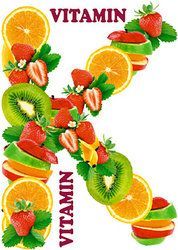Whether you accept it, avoid it or live somewhere in between, insurance coverage has become a defining issue for our profession. Patients increasingly expect to use their benefits, practitioners want to be compensated fairly for their time and expertise, and the system itself remains – at best – fragmented. The encouraging news is that coverage has expanded in meaningful ways. The challenging news is that reimbursement, across the board, remains inadequate.
The Power of Vitamin K
You may have heard rumblings in recent years that vitamin K helps reduce the risk of osteoporosis and cardiovascular disease, and is administered intravenously by some integrative medical doctors who combine it with high-dose vitamin C in cancer treatment.
Our original understanding of vitamin K involves its established role as a coenzyme in specific carboxylation reactions required for the synthesis of several clotting factors. In fact, drugs such as warfarin (and related vitamin K epoxide reductase inhibitors) work by limiting the ability of vitamin K to synthesize prothrombin and several other clotting proteins (Factors VII, IX and X). As such, these drugs act as blood thinners and are accompanied by the potential for certain side effects, such as easy bruising and internal bleeding.1 So, how then might vitamin K also be associated with osteoporosis, cardiovascular disease and cancer treatment?
Primary Forms of Vitamin K
You must first recognize that there are three primary forms of vitamin K, known as vitamin K1, vitamin K2 and vitamin K3. To make it more confusing, there are several forms of vitamin K2. Here is the overview:
Vitamin K1: Phylloquinone is found in appreciable amounts in plant foods, especially green, leafy vegetables (broccoli, lettuce, collards, spinach, Brussels sprouts, etc.), as well as soybeans, soy products, lentils, canola and olive oil and several other foods (liver, salad dressing, coleslaw). Absorption is surprisingly low (5–20 percent, depending on the food).
Vitamin K2 Menaquinone – There are several forms of menaquinone:

Menaquinone-9 (MK-9) is produced by intestinal bacteria, but not absorbed to any appreciable degree by the body.1
Menaquinone-7 (MK-7), derived from fermented soy (especially natto), is absorbed well and appears to play a key role in bone density via osteocalcin synthesis. MK-7 is also sold in supplement form is some countries.2
Menaquinone-4 (MK-4) is formed within animal bodies, often after they are injected with vitamin K3 (synthetic vitamin K, known as menadione). Menadione is put into poultry and swine rations, and appreciates in their tissues. These animals convert much of menadione to MK-4. Much of the vitamin K2 found in the body is usually from these sources (not gut bacteria-synthesized). Possibly gut-synthesized vitamin K2 (MK-9) is synthesized too far down the intestinal tract to allow absorption, whereas MK-4 found in poultry, swine products, and MK-7 from fermented soy products (natto) and vitamin K2 supplements (vitamin K1, MK-7 and prescription MK-4 in Japan) are absorbed in the small intestine within chylomicrons, upon concurrent consumption of fat. MK-4 shows impressive anti-cancer properties, such as apoptosis in leukemia and other malignant cells lines, and it appears to have a stronger influence on osteoblastic activity than does phylloquinone (K1).1
Vitamin K3: Menadione is a synthetic vitamin K. Menadione is no longer administered to humans who have a vitamin K deficiency, or injected into newborns shortly after birth, because it is associated with toxicity.1 Vitamin K does not pass from the placenta to the fetus very well. In a significant number of pregnancies, breast milk is virtually devoid of vitamin K, and newborns have no bacterial flora to synthesize their own vitamin K. Thus, classic vitamin K deficiency bleeding in the newborn usually occurs after 24 hours (usually the second day), and as late as the first week, with an incidence ranging between 0.25-1.7 cases per 100 births.1,6
Newborn infants were originally given an intramuscular injection of vitamin K3, but it caused hemolytic anemia, liver damage and brain damage (from excess bilirubin) as a side effect in some cases. Vitamin K is now administered to newborns as vitamin K1.1,7 Vitamin K1 is also the form of vitamin K used to correct vitamin K deficiencies in adults.1
However, vitamin K3 (menadione) is the form of vitamin K used intravenously, along with high-dose vitamin C, in cancer treatment (ratio is 100:1 of vitamin C: vitamin K3) by integrative practitioners, as discussed below.
Bone Mineralization
To consume the amount of vitamin K associated with a decreased risk of hip fracture in the Framingham Heart Study (about 250 mcg/day), an individual would need to eat a little more than 1/2 cup of chopped broccoli or a large salad of mixed greens every day, which is very attainable. This provides evidence that vitamin K1 and vitamin K2 from food alone, may be all that is required to support bone density function.1 This fact is intriguing when you consider that the average intake of vitamin K from the mixed North American diet is estimated to be between 300-500 mcg per day.3
In Japan, oral doses of 45 mg of MK-4 are given to osteoporosis patients, which has resulted in increased bone density and/or reduced fractures, and increased markers of bone formation. The pooled evidence involving seven Japanese trials shows that vitamin K2 supplementation has shown a 60 percent reduction in vertebral fractures and an 80 percent reduction in hip and other non-vertebral fractures. Thus, MK-4 administration to patients with osteoporosis may be an additional method to help manage their disease.7
Calcification of the fibrous cap is a late and significant step in the atherosclerosis process. Preventing arterial calcification may reduce deaths from vascular events. Once again, vitamin K2 appears to play a more important role than vitamin K1 in this regard.
Many vitamin K enthusiasts argue in favor of taking a vitamin K2 supplement to help prevent, slow or reverse the development of atherosclerosis, and to prevent and treat osteoporosis. Vitamin K2, in the form of MK-7, is available in Canada. In the U.S., only vitamin K1 is available in supplements, according to Medline Plus (National Institutes of Health).5
Protein S is also synthesized by osteoblasts, but its role in bone metabolism is unclear. However, children with inherited protein S deficiency suffer complications related to increased blood clotting, as well as decreased bone density.1
Cancer Treatment
The anticancer effects of sodium ascorbate (vitamin C) and vitamin K3, administered separately or in combination, on human ovarian, breast, endometrial and skin cancer cells lines has been demonstrated. When given separately, vitamin C or K3 has a growth-inhibiting action only at high concentrations, but when combined into a single lower-concentration mixture, they exhibit synergistic inhibition of cell growth that is 10-50 times greater that the single administration of vitamin C or vitamin K3 applied individually.
Studies show that these vitamins are toxic to certain cancer cells, but not to normal human cells in experimental studies. The combination of sodium ascorbate and vitamin K3 may also been shown to prevent metastasis in experimental studies.
Vitamin K3 appears to kill cancer cells via a mechanism called autoschizic cell death. Autoschizis, is a novel type of cell death characterized by exaggerated cell membrane damage and progressive loss of cell contents. During this process, the nucleus becomes smaller and cell size decreases by one-half to one-third of its original size. Co-administration of sodium ascorbate and K3 induces a cell cycle block on cancer cells, making it harder for them to grow and divide. This is called a G1/S block.
Antibiotics and Vitamin K Deficiency
A pre-existing low vitamin K state increases the risk of vitamin K deficiency with antibiotic use. As such, patients taking antibiotics should ensure they are eating sufficient dark green, leafy vegetables to acquire some additional vitamin K.1 In addition, they may also be inclined to supplement with vitamin K during this period.
References
- Shils ME, Shike M, Ross AC, Caballero B, Cousins RJ. Modern Nutrition in Health and Disease, 10th Edition. Lippincott Williams & Wilkins; 2006.
- Rhéaume-Bleue K. Vitamin K2 and the Calcium Paradox John Wiley & Sons Canada, Ltd.; 2012: pgs. 66-67.
- Krause M, Mahan LK. Food, Nutrition and Diet Therapy, 7th Edition. W.B. Saunders Company; 1984: pg. 118
- Gelieijnse JM, Vermeer C, Grobbee DE, Schurgers LJ, Knapen MH. Dietary intake of menaquinone is associated with a reduced risk of coronary heart disease: the Rotterdam Study. Am J Clin Nutr, 2004,134;11:3100-3105.
- Information on vitamin K. Medline Plus; U.S. National Library of Medicine, National Institutes of Health.
- Nimavat DJ. "Hemorrhagic Disease of Newborn." Medscape.com, last updated April 13, 2012.
- Cockayne S, Adamson J, Lanham-New S, Shearer MJ, Gilbody S, Torgerson DJ. Vitamin K and the prevention of fractures: systematic review and meta-analysis of randomized controlled trials. Arch Intern Med, 2006;166:1256-1261.
- Lamson DW, Plaza SM. The anticancer effects of vitamin K. Alt Med Review, 2003;8(3):303-318.



